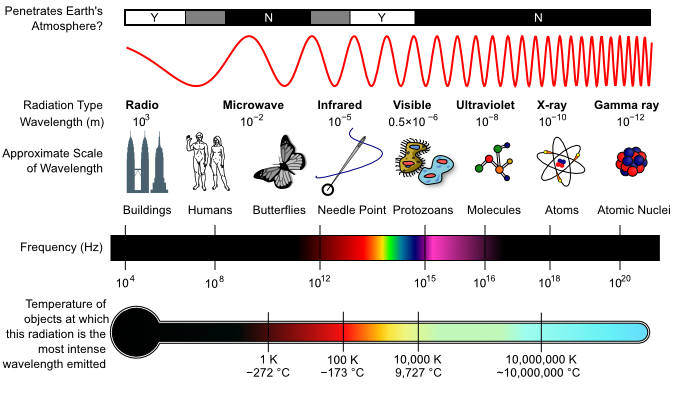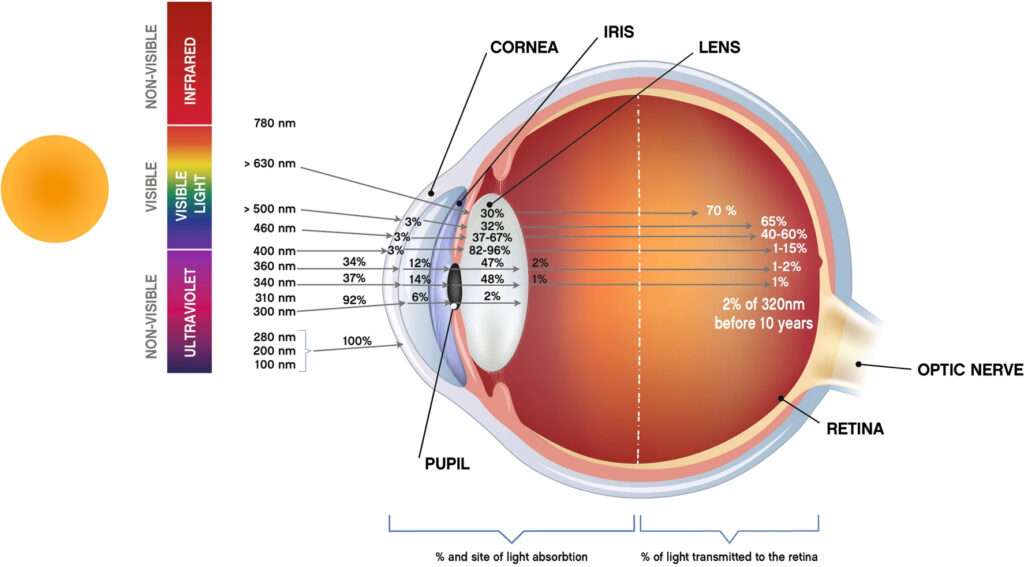Overview of Light and the Eye
Posted on 07 Oct. 2024 by Dr. Yvette Wang

Understanding Light
Light, specifically visible light, is a type of electromagnetic radiation that can be perceived by the human eye. It occupies a narrow band of the electromagnetic spectrum, with wavelengths typically ranging from 380 to 780 nanometers (nm), corresponding to frequencies from 750 to 420 terahertz (THz). Beyond visible light are other types of electromagnetic radiation, such as infrared (with longer wavelengths) and ultraviolet (with shorter wavelengths). Collectively, these are often referred to as optical radiation. (Figure 1)

Figure 1. Electromagnetic Spectrum (WikiPedia-Electromagnetic spectrum)
By Inductiveload, NASA – self-made, information by NASABased off of File:EM Spectrum3-new.jpg by NASAThe butterfly icon is from the P icon set, File:P biology.svgThe humans are from the Pioneer plaque, File:Human.svgThe buildings are the Petronas towers and the Empire State Buildings, both from File:Skyscrapercompare.svg, CC BY-SA 3.0, https://commons.wikimedia.org/w/index.php?curid=2974242
The behavior and interaction of light with different materials depend heavily on its wavelength. When visible light interacts with the retina, it triggers photoreceptor cells (rods and cones) to produce visual signals. Light is composed of quanta, called photons, which carry energy. The energy level of photons in visible light is sufficient to excite molecules in the retina and initiate the sensation of vision. The shorter wavelengths of light, such as blue light, have higher energy and can penetrate deeper into the eye. There are concerns that blue light potentially affect not just vision but also other physiological systems.
If the wavelength extends beyond this range (into the infrared), it no longer has enough energy to activate the visual molecules and becomes invisible to humans. Similarly, ultraviolet light, with even shorter wavelengths and higher energy, is mostly absorbed by the cornea and lens, preventing it from reaching the retina.
Light and Our Health
Light is essential for life on earth and plays a crucial role in regulating various biological and psychological processes in humans. The presence or absence of light, particularly visible and ultraviolet light, influences our mood, sleep patterns, and overall well-being.
Here are some ways light affects health:
- Circadian Rhythm Regulation: Visible light, especially in the blue wavelength (around 480 nm), is a key regulator of the circadian rhythm. The circadian rhythm is our body’s internal clock that synchronizes sleep-wake cycles, hormone release, and other bodily functions based on the 24-hour day/night cycle. Specialized photoreceptor cells in the retina called melanopsin-containing retinal ganglion cells are particularly sensitive to blue light. Exposure to blue light during the day enhances alertness and mood by stimulating cortisol production, while its absence at night promotes the release of melatonin, a hormone that induces sleep.
- Mood and Mental Health: Light exposure, particularly sunlight, is linked to mood enhancement. Sunlight triggers the production of β-endorphins in the skin, which are associated with feelings of pleasure and relaxation. Lack of sunlight exposure is often linked to Seasonal Affective Disorder, a type of depression that occurs at certain times of the year.
- Hormonal Health and Vitamin D Production: Ultraviolet B radiation from sunlight is essential for the synthesis of Vitamin D in the skin. Vitamin D is vital for bone health, immune function, and many other physiological processes. Insufficient exposure to sunlight can lead to Vitamin D deficiency, which is associated with several health disorders.
- Artificial Light and Health Risks: Excessive exposure to artificial light at night can disrupt the circadian rhythm and suppress melatonin production, increasing the risk of sleep disorders, obesity, and even some cancers. Short-wavelength blue light emitted by electronic screens and certain LED lights is particularly disruptive to sleep when used during nighttime.
Is Light Therapy Safe?
Light therapy, also known as phototherapy, is a treatment that involves exposing the eyes or body to specific wavelengths of light for a set period. It is commonly used to treat a range of health conditions, from mood disorders to skin conditions and sleep disturbances. Generally, it’s considered safe if used correctly, but it’s important to follow guidelines to avoid side effects like headaches or eye strain.
When using light therapy, eye safety is a primary concern. Although most modern devices filter out harmful ultraviolet (UV) light, prolonged exposure to very bright lights can still cause temporary discomfort or eye strain. It’s best to use light therapy boxes that are specifically designed for therapeutic use, as they ensure the light is evenly diffused and safe for the eyes.
For safety of using light therapy in the eye, calculating retinal exposures is crucial. To understand whether a light source is safe for the eyes, it’s essential to estimate how much light actually reaches the retina. However, this concept can be simplified:
The safety of a light source depends on how bright it is and how long you look at it. Your eyes’ exposure is influenced by factors such as the size of your pupils (which can vary with lighting conditions), the intensity of the light, and whether any protective layers (like sunglasses) are used. Simply put, brighter lights or staring directly at intense light sources (like the sun) for a prolonged period can overwhelm the retina, potentially causing damage.
When measuring exposure, professionals use technical terms like “retinal irradiance” and “retinal illuminance” to quantify this, but for general understanding, just think of it as a way to ensure that the brightness is at a comfortable and safe level for your eyes. For everyday situations, looking at regular indoor lighting or moderate natural sunlight is safe, but staring at very bright lights, like looking directly at the sun, can be harmful. (Figure 2)

Fig 2. Cougnard-Gregoire, A., Merle, B.M.J., Aslam, T. et al. Blue Light Exposure: Ocular Hazards and Prevention—A Narrative Review. Ophthalmol Ther 12, 755–788 (2023). https://doi.org/10.1007/s40123-023-00675-3
Summary
Light is more than just a way to see—it’s a vital part of our health. Visible light plays a significant role in regulating our sleep, mood, and hormone levels. While ultraviolet light helps produce Vitamin D, infrared light can promote cellular health. Light therapy, when used properly, can be an effective tool for improving health and treating specific conditions.
However, ensuring the safe use of light, especially when used therapeutically, requires some basic precautions. By keeping brightness at a comfortable level and avoiding excessive exposure to very bright sources, we can safely harness the benefits of light without harming our eyes.
